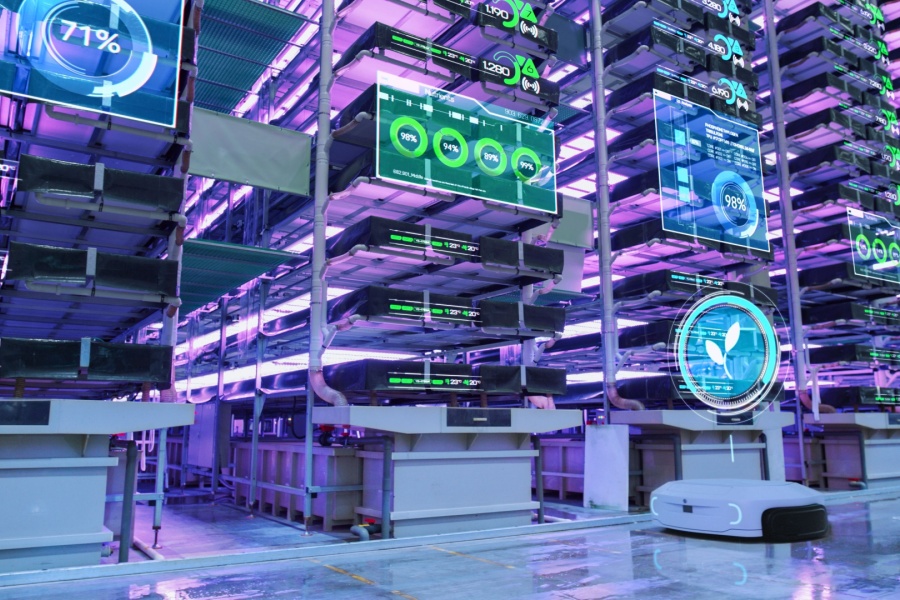Logística de Transporte
Industrias

Effective supply chain management not only minimizes costs, optimizes inventory levels, enhances customer satisfaction, and boosts profitability, but it also adapts to ever-evolving technology trends in logistics.
In recent years, the adoption of advanced technologies like Artificial Intelligence (AI), the Internet of Things (IoT), and blockchain has revolutionized supply chain management practices.
AI has allowed companies to analyze vast amounts of data in shorter periods of time to improve demand forecasting, inventory management, and route optimization.
IoT has also allowed real-time tracking of products, equipment, and shipments, improving visibility and monitoring across the supply chain. Blockchain technology ensures transaction transparency, traceability, and security, reducing fraud and errors.
The introduction of these new technology trends means that Integrating these technologies while partnering with a strong third-party logistics provider (3PL) often leads to increased efficiency, reduced lead times, and improved risk management.
However, it also means that supply chain management is no longer just a support function; it's a strategic differentiator that drives growth and innovation in the business ecosystem.
The Role of Artificial Intelligence
AI technologies are significantly revolutionizing supply chain processes by enhancing efficiency, accuracy, and overall performance with:
Ultimately, AI technologies play a pivotal role in optimizing supply chain operations, driving innovation, improving the overall customer experience, and improving internal operational efficiency.
Blockchain, IoT, and Analytics in Supply Chain Management
The transformative potential of these three technology trends in logistics—blockchain, IoT, and their accompanying analytics—is immense, with the potential to significantly revolutionize various industries.
Let's examine each one in turn.
Blockchain
Blockchain technology enhances transparency, traceability, and security in supply chains by recording every transaction or data exchange in a secure and tamper-proof manner.
This can help track the origins of products, verify authenticity, prevent fraud, and ensure ethical sourcing practices. Blockchain can also streamline processes, reduce paperwork, and increase efficiency in supply chain management.
Rather than relying on redundancy to cope with supply chain disruptions, blockchain enables proactive risk detection and mitigation before it's too late.
IoT
IoT connects physical devices together and enables real-time data collection, communication, and interaction.
This technology allows businesses to remotely monitor and control their assets, leading to improved operational efficiency and proactive maintenance practices.
By harnessing IoT data, organizations can make informed decisions, optimize resource utilization, and enhance customer experiences through personalized services and products.
But IoT can be used for more than just simple tracking. It can also efficiently transfer asset data in real-time and remotely control elements of transportation. Today’s powerful sensors and actuators are easy to integrate, and scalable cloud services can process large amounts of data.
Analytics
Leveraging data insights obtained through the use of analytics tools and techniques empowers organizations to make strategic decisions based on evidence rather than intuition. By analyzing historical and real-time data, businesses can forecast demand more accurately, optimize inventory levels, and mitigate risks such as stockouts or overstocking.
Advanced analytics can also help identify patterns, trends, and opportunities for process improvements, cost savings, and competitive advantage. Predictive analytics can improve resilience by enabling sensing, mitigating, and recovery from disruptive events and informing preparation for future disruptions.
Together, these technologies complement each other and provide a holistic approach to transforming businesses by enabling end-to-end visibility, operational efficiency, data-driven decision-making, and, ultimately, creating value for both enterprises and consumers.
In the Warehouse: Robotics and Automation
Warehouse robotics have revolutionized technology trends in the logistics industry and proved their worth as an investment by introducing autonomous robots to handle various tasks such as picking, packing, and inventory management.
These robots are equipped with advanced sensors, cameras, and software to navigate the warehouse environment and perform tasks precisely and efficiently.
These robots define the supply chain of today and tomorrow, helping drive down costs, providing labor stability, improving worker productivity, and reducing errors, among many other advantages.
The Benefits of Warehouse Robotics
Warehouse robotics provide benefits of many shapes and sizes, including but not limited to:
However, like any technology, robotics is not without downsides.
The Challenges of Warehouse Robotics
Warehouses also face challenges in implementing robotics and automation, including:
Despite these challenges, the overall impact of robotics and automation in warehouses is expected to grow as companies strive to improve efficiency, reduce costs, and meet the increasing demands of e-commerce and fulfillment services.
Embracing robotics technology can lead to a more streamlined and competitive warehouse operation in the long term and a smoother-running supply chain.
What About Self-Driving Vehicles in Logistics?
Self-driving vehicles, such as driverless trucks and drones, are revolutionizing the logistics industry by complementing other means of logistics automation.
These pilotless vehicles streamline operations by automating transportation and delivery, enabling real-time tracking and monitoring of goods in transit.
They also improve efficiency through optimized route planning and reduced idle time. Safety is also improved because human error and fatigue-related incidents are reduced.
The Advantages of Self-Driving Vehicles in Logistics
Similar to warehouse robotics, self-driving vehicles and driverless trucks benefit logistics in several ways:
And, not unlike warehouse robotics, they also have their disadvantages.
Challenges Facing Self-Driving Vehicles in Logistics
The challenges that self-driving vehicles present include:
Overall, self-driving vehicles have the potential to transform the logistics industry by improving efficiency, reducing costs, and enhancing safety.
As technology advances and regulations catch up, autonomous vehicles will likely play a more prominent role in transportation and logistics in the future.
Finding the Right 3PL Partner
Partnering with a 3PL is a simple, cost-effective way to get the most out of new and emerging logistics technology.
Here’s how:
By collaborating with 3PL providers, companies harness their expertise, achieve cost savings, and gain the flexibility needed to implement and sustain technology strategies within their logistics operations successfully.
This strategic partnership can pave the way for enhanced efficiency, improved customer service, and overall business growth.